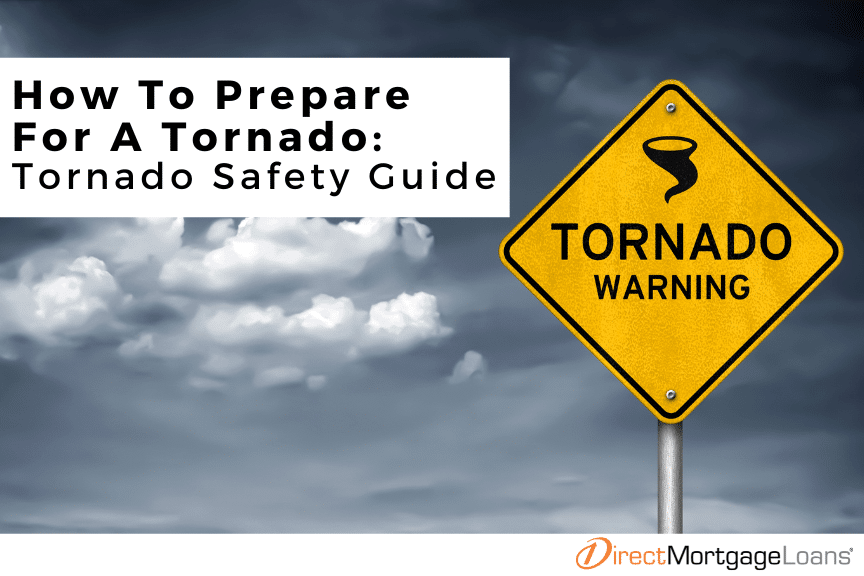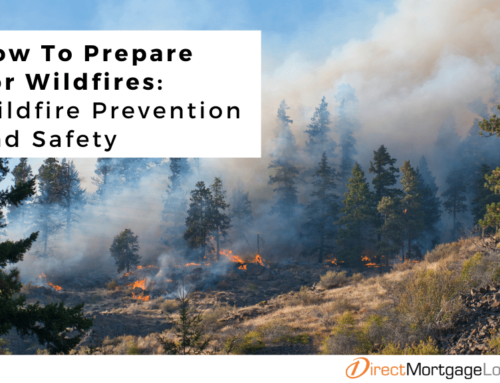The NOAA’s National Severe Storms Laboratory reports that approximately 1,200 tornadoes strike the U.S. each year. If you live in a region affected by tornados, it’s crucial to ensure that you and your home are prepared. In this article we’ll outline how to prepare for a tornado to keep yourself, your loved ones, and your home safe.
Subscribe to our blog to receive notifications of posts that interest you!
What is a tornado?
A tornado is a strong, swirling wind that extends from a thunderstorm and reaches the ground. It can pick up water, debris, and dust as it moves, making a visible funnel cloud. These storms can cause very strong winds of up to 300 miles per hour, leading to severe damage in their path.
Signs Of A Tornado
Tornadoes can form quickly, so recognizing the warning signs is essential. A darkening sky with a greenish tint often signals a forming tornado. Large hail is another key warning sign, as hailstorms often occur before or during a tornado. Additionally, a deep, rumbling roar from a low-lying cloud can indicate a tornado is nearby.
Tornado Watch vs Warning vs Emergency
Understanding the differences between a tornado watch, warning, and emergency is crucial for staying safe during severe weather. Each alert represents a different level of risk and requires specific actions to protect yourself and your loved ones.
What is a tornado watch?
A tornado watch is issued by the NOAA Storm Predication Center and is an early alert that tornadoes are possible in your area. While there is no immediate danger, it’s important to stay informed and be ready to act if conditions worsen. Keep an eye on the weather and ensure you have a plan in place.
What is a tornado warning?
A tornado warning is issued by your local NOAA National Weather Service Forecast Office and is a serious alert indicating that a tornado has been sighted in your area. This means that you should immediately seek shelter in a safe location within your home, such as a basement or a room away from windows.
What is a tornado emergency?
A tornado emergency is the most severe warning from the National Weather Service, indicating a confirmed and extremely dangerous tornado. This poses an immediate threat to life and property, so do not wait to act. If you are in the warned area, seek shelter immediately—your safety is the top priority.
How To Prepare For A Tornado
Being prepared for a tornado is important to keeping yourself and your loved ones safe. Taking steps to protect your home and family could help reduce risks during severe weather. Here’s how you can prepare:
Sign Up for Alerts and Stay Connected with Local Authorities
Make sure you’re signed up for Wireless Emergency Alerts (WEA) to receive important notifications about severe weather threats directly on your phone. Also, keep an eye on local weather forecasts and follow advisories from your local authorities.
Crate A Tornado Emergency Plan
To create a tornado emergency plan, begin by identifying the safest location within your home. Ideally, this is a small, interior room without windows, such as a bathroom or closet, on the lowest level of your home. This provides the best protection from flying debris.
Gather Tornado Shelter Supplies and Emergency Kit
Assemble a tornado shelter supply kit containing essential items for survival. This kit should include water, non-perishable food, first aid supplies, flashlights, batteries, a battery-powered radio, and other necessary items. Ensure these supplies are readily accessible and easily transportable to your designated shelter area.
Learn Emergency Skills
Learning essential emergency skills could make a significant difference during a tornado. Consider taking CPR and first aid courses to be prepared to assist yourself or others in case of injuries.
Conduct A Tornado Drill
Practicing your tornado plan ensures everyone in your household knows where to go and what to do. Conduct drills to familiarize family members with the shelter area and reinforce safety procedures.
How To Tornado Proof Your House
To effectively tornado-proof your house, take these actions ahead of time to prepare your home.
- Trim Trees: Cut back overgrown trees to prevent branches from causing damage during a tornado.
- Secure Outdoor Items: Tie down furniture and other outdoor items to prevent them from becoming hazardous in strong winds.
- Secure Your Doors: Make your garage doors and large windows more resistant to strong winds. Install exterior doors with three hinges and a deadbolt lock that is at least one inch long to protect your home.
- Check Gutters and Downspouts: Keep gutters clean to prevent water damage during storms.
- Maintain Your Roof: Regularly inspect and repair your roof to protect your home during severe weather.
What To Do During A Tornado
Knowing what to do during a tornado could significantly reduce the risk of injury.
Indoors
If you’re indoors at home, your safest bet is to move to a room away from any windows. Preferably, find a secure and safe location in a basement, bathroom or closet.
Outdoors
If you are caught outdoors when a tornado warning is issued, seek shelter in a sturdy building immediately. Avoid seeking shelter under trees, bridges, or overpasses.
Mobile home of vehicle
Mobile homes and vehicles offer very little protection during a tornado. If you are in a mobile home or vehicle when a tornado warning is issued, leave immediately and seek shelter in a sturdy building. If you cannot leave, get out of the vehicle and find a low-lying area to protect yourself from flying debris.
Work or School
s=”yoast-text-mark”>-contrast=”auto”>Follow the tornado emergency plan established by your workplace or school. This typically involves moving to a designated tornado shelter area such as a basement or interior hallway. Avoid large open spaces like cafeterias or auditoriums.
What to do after a tornado
Check For Injuries, Provide Basic First Aid and Seek Medical Attention
Prioritize the safety and well-being of yourself and others. Administer first aid as needed, but avoid moving individuals with suspected head, neck, or back injuries unless they are in immediate danger. Contact emergency services for professional medical assistance.
Assess Damage
Before entering your home or property, carefully evaluate the situation for potential hazards such as downed power lines, gas leaks, structural damage, and debris. It’s crucial to prioritize safety, and if you suspect any structural damage, contact a professional inspector.
Take Care of Yourself
The emotional and physical toll of a tornado can be significant. Ensure you are taking care of your well-being by eating nutritious meals, getting enough rest, and seeking support from friends, family, or mental health professionals. Consider contacting the Disaster Distress Hotline for additional support.
FAQ’s About How To Prepare For A Tornado
How can I receive tornado alerts?
To ensure you receive timely alerts, monitor local television broadcasts, enable Wireless Emergency Alerts (WEA) on your mobile device, and familiarize yourself with the outdoor tornado siren system in your area.
What supplies should be in my emergency kit?
To keep your family safe during an emergency, it’s important to have a well-stocked home emergency kit. The American Red Cross suggest including essentials like water (one gallon per person per day), a three-day supply of non-perishable food, a battery-powered radio, a flashlight, a first aid kit, extra batteries, and medications. Also, pack a whistle, a dust mask, plastic sheeting or duct tape, sanitation supplies, a wrench or pliers, a manual can opener, local maps, and a cell phone battery bank
How often should I conduct tornado drills with my family?
It is recommended to conduct family drills every six months to a year, depending on the tornado risk in your area. This will ensure that everyone knows the proper safety procedures.
How can I protect my pets during a tornado?
Pets are part of the family and should be included in your tornado emergency plans. Designate a safe room in your home where all family members, including pets, can shelter in place. Using crates could help keep your pets calm and secure during the storm.
How can I identify a safe room in my home?
To identify a safe room in your home, look for a small, interior space on the lowest level. Basements are often best, but if you don’t have one, choose a windowless room like a bathroom or closet. The safest rooms are away from exterior walls and have no windows or doors leading outside.






Leave A Comment
You must be logged in to post a comment.